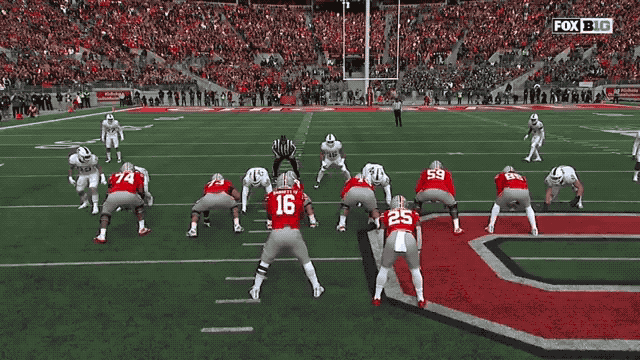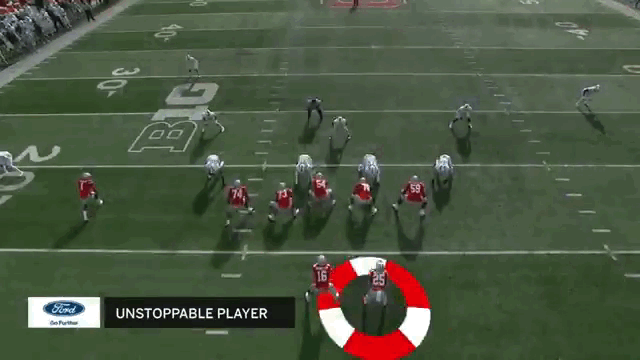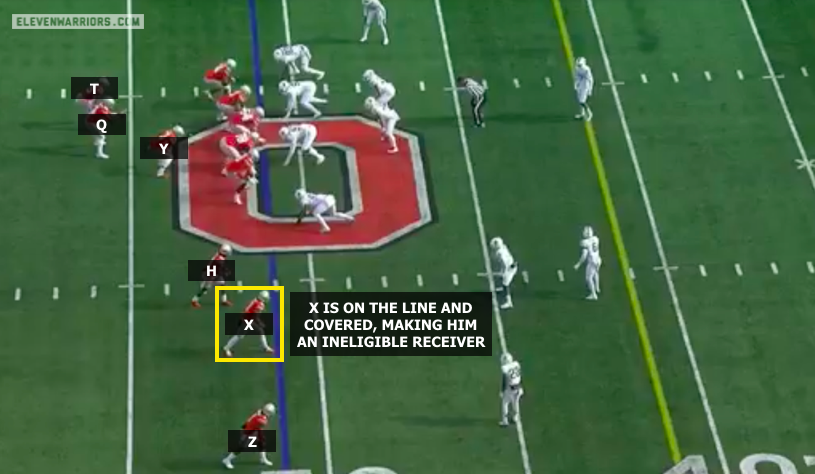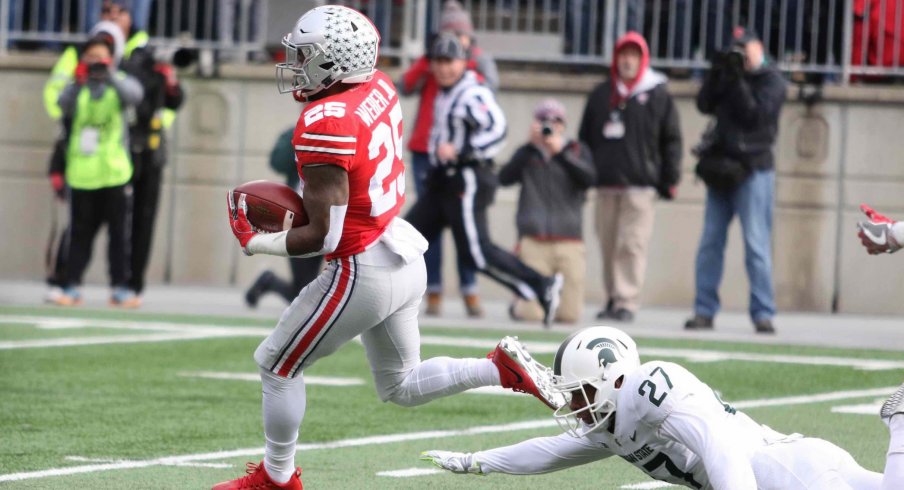"First of all, the game plan was very good. But that's secondary to the execution of the offensive line." - Urban Meyer following Ohio State's 48-3 win over Michigan State.
Since his arrival in Columbus five year ago, Urban Meyer has had one consistent thorn in his side: Mark Dantonio's relentless defense. Unlike the other conference rivals he's seen each year since taking over at Ohio State, Meyer had struggled to figure out ways to consistently move the football against the team from East Lansing, resulting in a pair of gut-wrenching losses to the Spartans in 2013 and 2015 that halted any hopes of a championship in both seasons.
Even when Meyer had found enough yardage to get past Dantonio's aggressive 4-3 setup, each contest between the two had been close, rugged battles like the 17-16 victories in both 2012 and 2016. As the two prepared to square off in round six last weekend, many (including even the most accomplished of gamblers) expected yet another low-scoring defensive struggle between the two programs that have reigned the Big Ten for much of this decade.
Of course, we got just the opposite instead.
From the opening whistle, the Buckeyes poured it on the Spartans, moving the ball at will against the nation's third-best run defense. Those that had called for J.K. Dobbins and Mike Weber to see the ball more were vindicated by a ground game that saw both players eclipse the 100-yard mark while J.T. Barrett added an easy 55 yards of his own. But for those of us that have followed this series closely, the scarlet and gray game plan was far more intricate than just handing off to the running backs.
One of the reasons Meyer hired Kevin Wilson and Ryan Day last winter was to solve the puzzle often posed by Spartans (and copied by similar opponents like Iowa), which attacked the option game that is foundational to Meyer's offensive philosophy. Instead of letting the offense punish his defense by always making at least one defender wrong, Dantonio had long trained his players to dictate which Buckeye would carry the ball and force it out of the hands of playmakers like Ezekiel Elliott and Carlos Hyde.
Instead of letting the Spartans hold the upper hand in this game of cat-and-mouse, Wilson and Day attacked the defense by adding a third option to the run game. Though bubble screens and tight end 'arrow' routes have been part of the Buckeye offense all season, the Spartans struggled to cover this horizontal stretching of their defense, with many second-level defenders (linebackers and safeties) forced back onto their heels and unable to act as the extra hitter that has often made the difference in past matchups.
But to get to those second-level players, the runner must first clear the initial line of defenders, which is where the physical play of Ohio State's offensive line came into play.
"Demetrious Knox was coming from the backside," senior center Billy Price said of Weber's 47-yard touchdown run in the first quarter. "I felt him and was able to come back off the linebacker, open up that hole, and again Mike's doing what Mike's supposed to do - running north and south, running with some tenacity."

Though the unit struggled to get much push the week before in Iowa City, they showed why Meyer often says he runs an 'O-line-driven program.' As you can see, Price worked together with the right guard, Knox, to execute a perfect combination block on the nose tackle before working up to the middle linebacker.
"Being uncovered (as a center), that's kind of the advantage of it, you know, being able to make sure we help our guards and get upfield on a second-level player," Price added.
All five starters up front were excellent for the Buckeyes on this afternoon, not only executing at a high level with their technique but also adding a physical element to the contest in hopes of wearing out the comparably undersized Spartan defense.
"I think, one of the big things with (the offensive line) was changing the line of scrimmage," noted Barrett postgame. "Those linebackers, they usually shoot the gap from Michigan State, so it's hard to get double-teams on those guys. But being that we were getting so much push off the ball with the D-linemen, it was a good day for (the offensive line) because they met the 'backers, instead of at the line of scrimmage, they met them three yards down the field and then our running backs did a great job of making those unblocked defenders miss and got some big hits."
Luckily, those linemen were given an outstanding game plan to execute, as it included countless wrinkles like the fold block from left guard Michael Jordan that sprung Weber's second touchdown.

While the play appeared to be just another inside handoff, Price uses his natural leverage at an angle to drive the nose tackle sideways and out of the play. Meanwhile, Jordan loops under him and pancakes the middle linebacker to create a huge seam for the back. With four receivers split out wide, the other linebackers and safeties were removed from the box, making it a five-on-five blocking scenario with a twist the defense wasn't expecting.
Though Meyer was quick to credit his players for their dominant performance after the game, he couldn't help but recognize the work put in by his staff during the week leading up to the game as well.
"(Greg) Stud(rawa), our O-Line coach, him and Kevin Wilson did a really nice job as far as game-planning," Meyer said. "We have made mistakes in the past where we run from normal run sets, you know those normal spread sets and try to get it down to six people, because the more people they bring into the box, they always bring an extra player there all the time."
But Weber's 80-yard touchdown was hardly the only example of Wilson, Day, and Studrawa using different formations to stress the defense. Knowing the Spartans would play a great deal of their vaunted Quarters coverage with two deep safeties on nearly every play, the Buckeyes rolled out an unbalanced formation that tied the defense in knots all day.
While traditional unbalanced sets place an extra lineman on one side of the ball to gain an advantage in that direction, this look placed all three receivers and the tight end (Y) to the same side, putting the defense in a constant bind as they tried to figure out how to defend the pass against all four while still holding contain against a run to the weak side.

Once in the set, the Buckeyes showed off the full variety of their running game. Plays like Bash (below) allowed Dobbins and Weber to get to outside with plenty of blockers in front of them.
As you can see, the Buckeyes don't even try to block the backside end and corner, leaving the offense with an even nine-on-nine blocking edge in the direction of the play.
The Buckeyes created havoc in the Spartans' run fits all day, attacking and adding the vulnerable B and C-gaps to the strong side as the defense continued to line up two players outside of the weak-side tackle. This alignment had long given the Buckeyes trouble, as the end is responsible for the quarterback run while the corner fills that C-gap if the back were to run that way, creating a version of the popular scrape-exchange often used to combat shotgun option runs.
But the Buckeyes never attacked the weak-side of the formation, adapting page after page of their playbook to fit this new formation, such as this lead zone play that uses the tight end like a fullback leading the way from the backfield.
This new formation was most devastating near the goal-line, however. By moving the alignment of the running back to either side of Barrett, the Buckeyes could choose which defender to read in the option, looking for a numerical advantage and leaving the backside scrape-exchange useless.
With Barrett's 220 lb frame falling forward, Wilson and Day were unafraid to let him go one-on-one with a defensive back near the goal-line if need be.
However, they'd also give him protection in the form of a pulling guard and a swing pass to the running back with an adaptation of the Power-Read play, the same one they've used to decimate the Spartans' in-state rival for years. Instead of handing off or tossing to the back on a sweep, Barrett would read the second-level defender and decide whether to keep and run up the gut himself or throw it to the back behind the blocking of all three receivers.
Even though one of the wide receivers was often ineligible, being covered up by another player outside of him on the line of scrimmage, Wilson and Day gave Barrett the option to call for bubble-screens whenever the Spartans cheated and failed to put three defenders outside. Once they'd hit that play for a big gain, they even called for a fake-bubble screen that sent both blockers downfield, all in an effort to keep the defense from cheating in any direction.
But the unbalanced look wasn't the only formation tweak we saw from the Buckeyes, as 'H' receiver K.J. Hill was often lined up much closer inside than his normal split between the outside receiver and the tackle or tight end. By shrinking his alignment inside, he effectively added an extra gap for the offense the same way a double-tight end look might, making life difficult for edge defenders and helping to spring the backs on outside runs like Bash.
Just as they had with the unbalanced look, Wilson and Day ensured that the Spartans couldn't cheat to take away the run against this look by incorporating some of their existing pass plays, such as the Bubble Y-over concept (aka Saints) that sprung Binjimen Victor for a long touchdown catch, just as he'd done against Rutgers one month ago on a variation of the same play.
While the headline this week may have been the execution of the offensive line and the running backs, it's worth noting the plan they were given to carry out was made far easier by the fact that nearly every play was one they'd ran countless times before. From Michigan State's perspective, though, new alignments caused chaos all afternoon.
As Mike Leach famously told the New York Times in 2005, "There's two ways to make it more complex for the defense. One is to have a whole bunch of different plays, but that's no good because then the offense experiences as much complexity as the defense."
"Another is a small number of plays and run it out of lots of different formations. That way, you don't have to teach a guy a new thing to do," he says. "You just have to teach him new places to stand."



